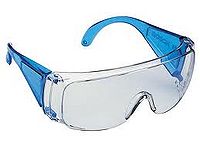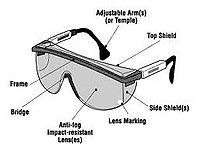Protective Goggles
Protective Goggles are a must in lots of occupations exactly where risk of vision injury is actually high as well as serious sufficient to require these kinds of equipment. Needless to say without safety supplies, equipment, or insures for the face it is wide open and prone to attacks by simply germs, toxins, all kinds of illnesses that commence with a small dysfunction. After a while, the true injuries along with diseases set out to mature and grow too solid to avoid in your body somewhere according to what type it really is.
Common Parts
Lenses
Most of the safety glasses have plastic polycarbonate lenses. They are stronger than regular lenses, are impact-resistant, and come in prescription and non-prescription (plano or zero-power lens) forms.
Markings on safety glasses
The manufacturer or supplier logo is marked (or etched) on all approved safety lenses, frames (front and temple), removable side shields, and other parts of the glasses, goggles, or helmets.
Frames
Safety frames are stronger than street-wear frames and are often heat resistant. They are also designed to prevent lenses from being pushed into the eyes.
=Typical Materials Used
Polycarbonate
- Strongest material for impact resistance
- Lightweight
- Can be coated for scratch resistance
- Most have built-in UV radiation protection
Plastic (CR39)
- About one-half the weight of glass
- Resistant to solvents and pitting
- More choices for coatings and tinting
Trivex
- More impact resistant than CR39 Plastic
- Less impact resistant than polycarbonate
- UV radiation absorption properties
Glass
- High-density material (heavy lenses)
- Loses impact resistance if scratched
- Does not meet impact criteria as set by CSA
Fit
Ensure your safety glasses fit properly. Eye size, bridge size and temple length all vary. Safety glasses should be individually assigned and fitted.
Wear safety glasses so that the temples fit comfortably over the ears. The frame should be as close to the face as possible and adequately supported by the bridge of the nose.
Care
- Safety glasses need maintenance.
- Clean your safety glasses daily. Follow the manufacturer's instructions. Avoid rough handling that can scratch lenses.
- Scratches impair vision and can weaken lenses.
- Store your safety glasses in a clean, dry place where they cannot fall or be stepped on. Keep them in a case when they are not being worn.
- Replace scratched, pitted, broken, bent or ill-fitting glasses. Damaged glasses interfere with vision and do not provide protection.
- Replace damaged parts only with identical parts from the original manufacturer to ensure the same safety rating.
How Do Safety Glasses and Goggles Differ From Regular Eyeglasses?
Safety eyewear must conform to a higher standard of impact resistance than regular eyeglasses, which optical professionals sometimes call "dress eyewear." This higher standard applies to both the lenses and the frames of safety glasses and goggles.
Safety glasses may have prescription lenses or non-prescription (also called "plano") lenses. Regardless of their size or the durability of the frame and lenses, regular prescription eyeglasses do not qualify as safety glasses unless they meet specific criteria.
In the United States, the federal government establishes safety guidelines for workplaces, to decrease the risk of on-the-job injuries. The Occupational Safety and Health Administration (OSHA) within the U.S. Department of Labor oversees safety practices in the workplace and in educational settings.
OSHA has adopted safety eyewear standards established by the American National Standards Institute (ANSI), a private, non-profit organization that creates quality and safety standards for a wide variety of products.
The ANSI standard applying to eye safety includes several types of eye protection devices, including eyeglasses (both prescription and non-prescription), goggles, face shields, welding helmets and full-face respirators.
ANSI Standards for Safety Eyewear
Updated ANSI safety eyewear standards include the following key features:
For the basic impact tests, lenses are tested separately (not mounted in a frame). For the high impact classification, the frame and lenses are tested together as a unit.
Non-prescription lenses used for high impact testing are considered to be structurally weaker than prescription lenses made of the same material; the prescription lenses are generally thicker.
Thinner prescription safety lenses are now allowed, if they meet the high impact testing requirements. (Previously, all prescription safety lenses had to have a minimum thickness of 3 mm, making them significantly thicker and heavier than regular eyeglass lenses.)
Safety lenses now have two classifications of performance: basic impact and high impact.
The "drop ball" test determines the basic impact safety classification for lenses. In this test, a one-inch diameter steel ball is dropped onto the lens from a height of 50 inches. To pass, the lens must not crack, chip or break. All glass safety lenses must undergo this test. For plastic safety lenses, however, only a statistical sample of a large batch of lenses needs to be tested.
In high impact testing, a high velocity test is performed by shooting a quarter-inch diameter steel ball at the lens at a speed of 150 feet per second. To pass, the lens must not crack, chip or break, and it must not become dislodged from the lens holder.
Video

